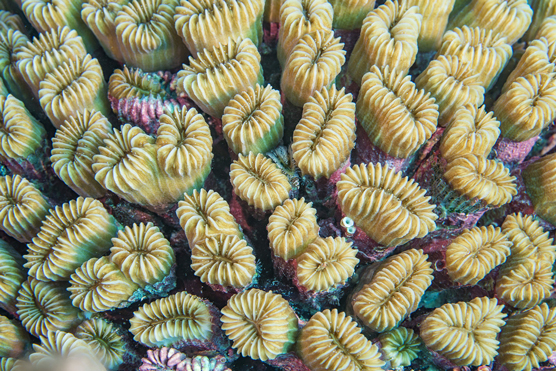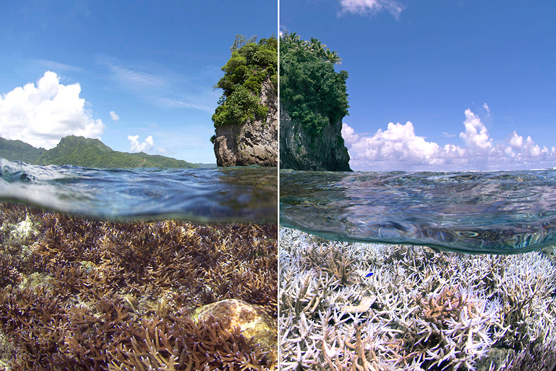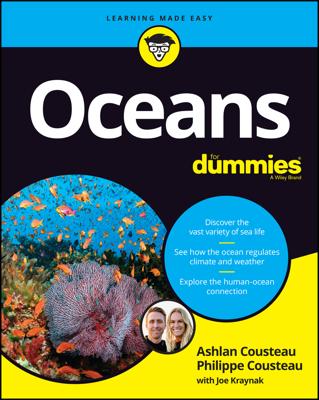Coral reefs
While coral reefs may seem like lifeless rocks, they are actually incredibly complex ecosystems created by a marine invertebrate called a coral polyp. Classified as cnidarians (pronounced ny-dare-ee-uhns), they’re related to jellyfish and sea anemones. Over 2,500 species of coral exist, and they can be broken down into two groups: hard (rigid) and soft (flexible). The hard ones (such as brain coral and elkhorn coral) are referred to as “the reef builders” because they create the hard material that forms the basis for the ecosystem. The soft ones (such as sea fingers and sea whips) hang out in and around reefs. Coral reefs exist in relatively shallow water (usually no deeper than around 100 feet) because the algae (zooxanthellae) that live symbiotically inside the coral polyps, providing them with essential nutrients, requires sunlight.Coral polyps (see the following figure) build large reefs through the process of creating small homes for themselves out of calcium carbonate that are tightly packed next to other coral polyps that do the same thing. Reefs grow when subsequent generations of coral polyps stack their homes on top of their deceased predecessor adding height and volume to the structure. As they create more and more homes, they end up with a massive system similar to a human apartment complex which is formally known as a “colony.” All the polyps within a colony are genetically identical, and the colony as a whole is considered a single living organism.
As more and more colonies are built (by the same or different species of hard coral), a coral reef is formed. Depending on its size, a healthy reef could have hundreds of thousands to billions of diverse coral polyps living together in close quarters, just like a large human city. Different colonies even engage in turf wars with the polyps of one colony stinging those of the other colony. (Can’t we all just get along?) So, what may look like a bunch of rocks, is actually a living ecosystem with a dazzling array of colors and shapes that would make Picasso cry. Cristina Mittermeier—www.sealegacy.org
Cristina Mittermeier—www.sealegacy.orgClose-up of coral polyp.
But that’s not all. In the process of building homes for themselves, coral polyps lay the foundation for rich ecosystems that provide food and shelter for highly diverse populations of other marine organisms, including thousands of species of fish, invertebrates, plants, algae, sea turtles, birds, and marine mammals. The largest coral reef on the planet is the Great Barrier reef, and it can be seen from space. Coral reefs are some of the most stunning places on the planet (see the following figure).
 Shane Reynolds—www.ColorEarth.tv
Shane Reynolds—www.ColorEarth.tvCoral reefs like this on off the coast of Saudi Arabia are rich in diversity
Soft corals also build their own homes but they do so out of spongy material, so the homes are more flexible and fragile. (I know, this is sounding like the story of the three little pigs, right?) While soft corals don’t qualify as reef builders, they’re a beautiful part of some reef systems.
The value of coral reefs extends far beyond their beauty and the fact that they provide food and shelter for a rich community of marine life. They’re also the first line of defense against waves and storms that threaten to batter the coasts. The World Wildlife Fund and the Smithsonian Institute estimate the commercial value of coral reefs worldwide at a minimum of $1 trillion per year, $300 to $400 billion of which is attributed to food, tourism, fisheries, and medicines.
Coral is actually white because it’s made from calcium carbonate, which is essentially limestone. In fact, most limestone is actually ancient coral reefs, and if you look closely at limestone buildings, sometimes you can see the outline of the coral polyps and ancient shells that lived on the reef. What gives living corals color are the zooxanthellae (algae) that live in a symbiotic (mutually beneficial) relationship with the coral polyp. The zooxanthellae, which live inside the coral polyps, capture energy from the sun and turn it into food (like a plant), which is shared with the coral polyps. In exchange, the coral provides the zooxanthellae with a place to live and chemical compounds needed for photosynthesis.
Corals come in a variety of shapes, which vary mostly by the species that build the colonies, but their shape is also influenced by the wave action where they live. In more turbulent waters, they tend to grow as mounds or flattened shapes, like tables, whereas in calmer seas they form more intricate branching structures.
Coral reefs at risk
Coral reefs are disappearing at a terrifying rate. Up to 40 percent of the world’s coral has died in the last few decades, including half of Australia’s Great Barrier Reef. How could this happen? Well, coral may be hard as a rock, but the coral polyps that build it are sensitive to changes in their habitat.Two main factors threaten the coral reefs—heat and pollution. First consider the impact of heat. As the temperature of the ocean rises (due to global warming), in many places it frequently passes the threshold tolerable for corals to live. When that happens—the zooxanthellae living inside the polyps begin to produce toxins, or they become parasitic, so the coral essentially kicks them out of the house. And without the zooxanthellae, the polyps starve. The second threat is pollution in the form of excess nutrients in runoff, chemicals in plastics and sunscreens, and other sources, which can kill the zooxanthellae, the coral, or both.
Because zooxanthellae are the source of the coral’s color, when they’re gone, the coral turns white, a phenomenon called coral bleaching (see the following figure). Even if the coral polyps are still alive, all you see is the white because polyps are basically transparent without their zooxanthellae. Unfortunately, even if the polyps survive, they begin to slowly starve to death. So, while coral bleaching isn’t necessarily a death warrant, it’s a serious warning sign that the coral is stressed and at increased risk of death. If water conditions don’t return to normal relatively quickly, the polyps will die, and all that beauty, mystery, wealth and diversity dies with them.
 Underwater Earth / XL Catlin Seaview Survey—www.underwater.earth
Underwater Earth / XL Catlin Seaview Survey—www.underwater.earthOyster reefs
Not to be outdone by the coral polyps, oysters create their own colonies and, in the process, create rich ecosystems that provide food and shelter for a rich marine community, not as diverse as coral mind you, but still pretty diverse.So, if hard corals build coral reefs, how do oysters go about building oyster reefs? Well, it all starts with baby oysters (okay, technically oyster larvae that develop into juveniles called spat), which, at this stage of their lifecycle are free-floating. At the mercy of currents and tides, they float around aimlessly in salty or brackish water until they find something to latch onto — a rock, a shell, even another oyster. After taking hold, they grow and release more larvae, some of which settle down nearby, and the cycle continues until a structure is formed worthy of being called a reef.
These reefs are wonderful places for other benthic marine animals to latch onto, including mussels, barnacles, and sea anemones. Collectively, all these animals and the creatures attracted to the structures they create form an abundant food source for many species of fish and other marine animals, not to mention humans who love slurping down oysters on the half-shell. Along with food, oyster reefs provide a nursery ground for many creatures, including shrimp, herring, striped bass, flounder, blue crabs, and more.
Oysters and other bivalves (clams and mussels) are incredible little water filtration machines. A single oyster can filter two gallons of water every hour! Just search online for “oyster filtration video”—it’s mind blowing.
Oyster reefs are important for water quality, fish stocks, human food, and (like coral reefs) they protect the coastlines from waves, tides, and storms.
